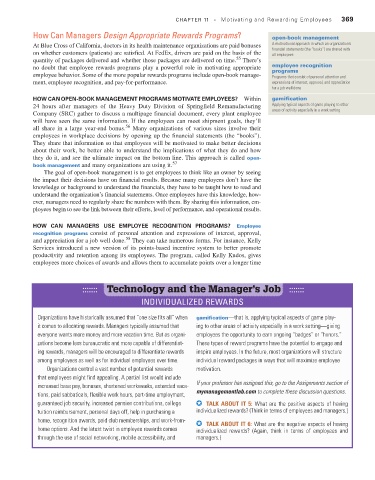Page 370 - Fundamentals of Management Myths Debunked (2017)_Flat
P. 370
CHAPTER 11 • Motivating and Rewarding Employees 369
How Can Managers Design Appropriate Rewards Programs? open-book management
At Blue Cross of California, doctors in its health maintenance organizations are paid bonuses A motivational approach in which an organization’s
on whether customers (patients) are satisfied. At FedEx, drivers are paid on the basis of the financial statements (the “books”) are shared with
all employees
55
quantity of packages delivered and whether those packages are delivered on time. There’s
no doubt that employee rewards programs play a powerful role in motivating appropriate employee recognition
programs
employee behavior. Some of the more popular rewards programs include open-book manage- Programs that consist of personal attention and
ment, employee recognition, and pay-for-performance. expressions of interest, approval, and appreciation
for a job well done
HoW can oPen-Book ManageMent PrograMs Motivate eMPloyees? Within gamification
24 hours after managers of the Heavy Duty Division of Springfield Remanufacturing Applying typical aspects of game playing to other
Company (SRC) gather to discuss a multipage financial document, every plant employee areas of activity especially in a work setting
will have seen the same information. If the employees can meet shipment goals, they’ll
56
all share in a large year-end bonus. Many organizations of various sizes involve their
employees in workplace decisions by opening up the financial statements (the “books”).
They share that information so that employees will be motivated to make better decisions
about their work, be better able to understand the implications of what they do and how
they do it, and see the ultimate impact on the bottom line. This approach is called open-
book management and many organizations are using it. 57
The goal of open-book management is to get employees to think like an owner by seeing
the impact their decisions have on financial results. Because many employees don’t have the
knowledge or background to understand the financials, they have to be taught how to read and
understand the organization’s financial statements. Once employees have this knowledge, how-
ever, managers need to regularly share the numbers with them. By sharing this information, em-
ployees begin to see the link between their efforts, level of performance, and operational results.
HoW can Managers Use eMPloyee recognition PrograMs? Employee
recognition programs consist of personal attention and expressions of interest, approval,
58
and appreciation for a job well done. They can take numerous forms. For instance, Kelly
Services introduced a new version of its points-based incentive system to better promote
productivity and retention among its employees. The program, called Kelly Kudos, gives
employees more choices of awards and allows them to accumulate points over a longer time
::::::: Technology and the Manager’s Job :::::::
INDIVIDuAlIzED REWARDS
Organizations have historically assumed that “one size fits all” when gamification—that is, applying typical aspects of game play-
it comes to allocating rewards. Managers typically assumed that ing to other areas of activity especially in a work setting—giving
everyone wants more money and more vacation time. But as organi- employees the opportunity to earn ongoing “badges” or “honors.”
zations become less bureaucratic and more capable of differentiat- These types of reward programs have the potential to engage and
ing rewards, managers will be encouraged to differentiate rewards inspire employees. In the future, most organizations will structure
among employees as well as for individual employees over time. individual reward packages in ways that will maximize employee
Organizations control a vast number of potential rewards motivation.
that employees might find appealing. A partial list would include
increased base pay, bonuses, shortened workweeks, extended vaca- If your professor has assigned this, go to the Assignments section of
tions, paid sabbaticals, flexible work hours, part-time employment, mymanagementlab.com to complete these discussion questions.
guaranteed job security, increased pension contributions, college TAlK AbouT IT 5: What are the positive aspects of having
tuition reimbursement, personal days off, help in purchasing a individualized rewards? (Think in terms of employees and managers.)
home, recognition awards, paid club memberships, and work-from- TAlK AbouT IT 6: What are the negative aspects of having
home options. And the latest twist in employee rewards comes individualized rewards? (Again, think in terms of employees and
through the use of social networking, mobile accessibility, and managers.)

